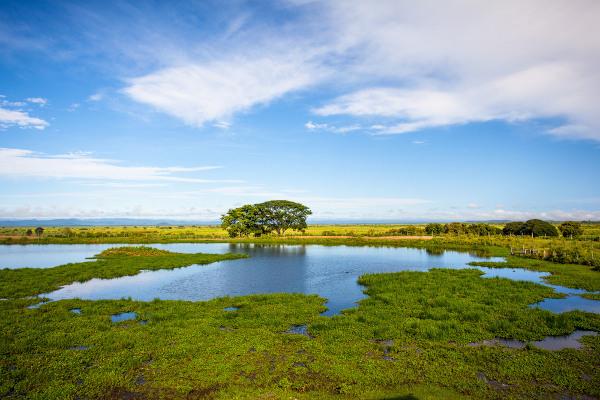At burned in the Pantanal, a biome located in the Midwest and in parts of Bolivia and Paraguay, are quite common in Winter, a time when temperatures increase and air humidity decreases in this location. These climatic factors associated with human actions can generate fires of varying degrees of intensity and significantly harm the biome.
Read too: Environmental impacts caused by mining
Origin of fires
The natural winter drought in Midwest region it may be accompanied by natural outbreaks of fire, but in isolated areas, with the performance of winds and dry weather. Outbreaks can also appear around the rainy season, with the action of lightning and other natural phenomena.
However, what has been seen lately is a considerable increase of these outbreaks in very dry seasons and in large areas, which suggests that these outbreaks are caused by human action.

Recently, a decrease of rains at the beginning of the year, causing, during droughts, the rivers reduce their levels even more, also reducing the wetland areas. In this way, drier soils emerge, favoring the agricultural practice of the region, which uses the
fires to clear vegetation and develop pastures and crops.
This decrease in rainfall may be associated with logging dthe Amazon, which has been growing over the years. More severe droughts, increased temperature and less humidity are the ideal factors for small fires to get out of control.
Main reasons for fires
THE low amount of rain of recent periods contributes to the increase in the number of fires, as the humidity decreases, leaving dry weather, in addition to high temperatures, with averages above 30ºC.
However, such fires do not only occur because of these mentioned factors. Specialists, such as biologists and climatologists, believe that a large part of the outbreaks – not to say all – is caused by human actions linked to:
agribusiness;
logging.
Do not stop now... There's more after the advertising ;)
O agribusiness is a strong economic sector in the Midwest region, being very important for the composition of the GDP of the states in the region. In the area of occurrence of the Pantanal, between Mato Grosso and Mato Grosso do Sul, the flooded plains are increasingly smaller, which increases the area of pasture and planting of brachiaria, a plant that helps in feeding the cattle.
Associated with livestock, fires are used as a form of deforestation to clear the pasture area, something common in the region. However, the aforementioned climatic conditions cause small outbreaks to become uncontrollable burnings.
Deforestation with burning equates to an immense environmental problem, but one that for many is justified by the cattle-raising and agricultural economy, highlighting the planting of soybeans in the Pantanal region. But let's not forget that money isn't food, so environmental preservation is essential.
See too:Environmental impacts caused by agribusiness in Brazil
Burning data in the Pantanal
The burning season in the Midwest region reaches its apex during the winter months, season with scarcity of rain and low humidity. Thus, during this period, it is natural that there will be an increase in the number of fires, but in recent years, this number has been of great concern to environmentalists.
According to the National Institute for Space Research (Inpe), the year 2020, until September, already has more fires than the entire year of 2019. Look at the table from 2015 to 2019 in relation to fire outbreaks:
Year |
Number of fire outbreaks |
2015 |
4.458 |
2016 |
5.814 |
2017 |
5.773 |
2018 |
1.691 |
2019 |
10.025 |
As of September 2020, the number of wildfires surpassed 15,800, a frightening increase if we take into account the aforementioned period. Also according to Inpe, the biome wetland already had 12% of its area destroyed in 2020 with the action of fire, which corresponds to an area of 18.6 km².
O Encontro das Águas State Park, located in Poconé, just over 100 kilometers from Cuiabá, had more than 80% of its area destroyed with the burnings of 2020. This park is famous for concentrating the greater amount of jaguars of the world, which attracts tourists from various countries around the globe.
When comparing the first half of 2020 with the first half of 2019, there was a 206% increase in the number of fires, with the highest record since 1998/1999, when the measurements started. These numbers are of great concern, especially when taking into account the unprecedented damage to the fauna and flora of this biome.
Also access: The relationship between environmental impacts and the emergence of diseases
Consequences of fires
The consequences of excessive burning in the Pantanal are serious, especially for fauna and flora. The fires generate direct and indirect effects, the latter being perceived only in the long term.
As direct and immediate consequences, we can mention animals with burns, poisoning and the death of several of them. Some animals from the Pantanal, such as jaguars, capybaras, tuiuiús, macaws, alligators, armadillos, anacondas and anteaters, usually take refuge from the imminent danger. However, this escape goes to the animal's body limit, which can cause it to leave its natural habitat and become disoriented due to smoke and ash. Thereby, some animals end up dying of tiredness or even hunger, as they do not find food in a hostile environment that is different from what they are used to.
Animal deaths are among the most serious consequences of fires, as, in addition to being a great biological loss, there is the imbalance in food chain of the biome. An example is the case of jaguars, the largest feline in the Americas and which controls the population of other animals, such as capybaras and deer.

In the flora, burning trees and plants cause the Pantanal birds move to other areas. Without home and food, many birds suffer even if they find another shelter, as there is no guarantee that they will find food. Burnt nests, eggs and hatchlings are another example of the tragedy that sets in with excessive burning.
The long-term consequences are related to ecosystems. the burnings increase the levels of pollution, which can be reduced with the presence of trees. But with the burned trees, pollution grows, which affects not only the Pantanal region, but several others adjacent to it. Furthermore, the population that lives and survives on the Pantanal's resources is also extremely harmed.
The cities that shelter the Pantanal suffer from the smoke that covers the region, which aggravates respiratory problems and other related diseases with terrible air quality. Another serious consequence is the ashes left by the fire. When the first rains arrive, these ashes will be transported to the rivers, which will harm aquatic ecosystems and also human consumption. These events will leave sad marks for everyone.
By Attila Matthias
Geography teacher

